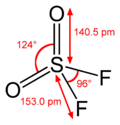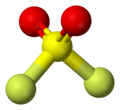Sulfuryl fluoride
| |||
| Names | |||
|---|---|---|---|
| IUPAC name
Sulfuryl fluoride | |||
| Other names
Sulfonyl fluoride; Sulfur dioxide difluoride; Sulphuryl fluoride; Sulfuryl difluoride | |||
| Identifiers | |||
| 2699-79-8 | |||
| ChEBI | CHEBI:39287 | ||
| ChemSpider | 16647 | ||
| |||
| Jmol-3D images | Image | ||
| PubChem | 17607 | ||
| |||
| Properties | |||
| SO2F2 | |||
| Molar mass | 102.06 g/mol | ||
| Appearance | colourless gas | ||
| Density | 4.172 g/L (gas), 1.632 g/mL (liquid under compressed gas at 0 °C) | ||
| Melting point | −124.7 °C (−192.5 °F; 148.5 K) | ||
| Boiling point | −55.4 °C (−67.7 °F; 217.8 K) | ||
| low | |||
| Solubility in other solvents | SO2 | ||
| Structure | |||
| tetrahedral | |||
| Hazards | |||
| Main hazards | toxic | ||
| NFPA 704 | |||
| Related compounds | |||
| Related compounds |
SO2Cl2, SO2ClF, SF6, SO3 | ||
| Except where noted otherwise, data is given for materials in their standard state (at 25 °C (77 °F), 100 kPa) | |||
| | |||
| Infobox references | |||
Sulfuryl fluoride (also spelled sulphuryl fluoride) is the inorganic compound with the formula SO2F2. This easily condensed gas has properties more similar to sulfur hexafluoride than sulfuryl chloride, being resistant to hydrolysis even up to 150 °C.[1]
Structure, preparation, reactions
The molecule is tetrahedral with C2v symmetry. The S-O distance is 140.5 pm, S-F is 153.0 pm. As predicted by VSEPR, the O-S-O angle is more open than the F-S-F angle, 124° and 97°, respectively.[1]
One synthesis begins with the preparation of potassium fluorosulfite:[2]
- SO2 + KF → KSO2F
This salt is then chlorinated to give sulfuryl chloride fluoride:
- KSO2F + Cl2 → SO2ClF + KCl
Further heating at 180 °C of potassium fluorosulfite with the sulfuryl chloride fluoride gives the desired product:[3]
- SO2ClF + KSO2F → SO2F2 + KCl + SO2
Heating metal fluorosulfonate salts also gives this molecule:[1]
- Ba(OSO2F)2 → BaSO4 + SO2F2
It can be prepared by direct reaction of fluorine with sulfur dioxide:
- SO2 + F2 → SO2F2
Sulfuryl fluoride is unreactive toward molten sodium metal.[1] Similarly it is slow to hydrolyze, but eventually converts to sulfur trioxide.[4][5]
Use as a fumigant
Originally developed by the Dow Chemical Company, sulfuryl fluoride is in widespread use as a structural fumigant insecticide to control drywood termites, particularly in warm-weather portions of the southwestern and southeastern United States and in Hawaii. Less commonly, it can also be used to control rodents, powderpost beetles, deathwatch beetles, bark beetles, and bedbugs. Its use has increased as a replacement for methyl bromide, which was phased out because of harm to the ozone layer. It is an alternative to the use of phosphine, which is acutely toxic.[6]
Sulfuryl fluoride is marketed by three manufacturers, under four different brand names. Vikane (Dow) (EPA Reg. No. 62719- 4-ZA) has been commercially available since the early 1960s, with Zythor (marketed by competitor Ensystex of North Carolina) (EPA Reg. No. 81824- 1-AA) being more recently introduced gradually as its use is approved by individual states (in Florida circa 2004, but not in California until October 2006, for example). Dow recently has begun marketing sulfuryl fluoride as a post-harvest fumigant for dry fruits, nuts, and grains under the trade name ProFume (EPA Reg. No. 62719- 376-AA). [7] Most recently Drexel Chemical Company has registered Master Fume (EPA Reg. No. 19713-596-AA) for the structural market, competing against Vikane and Zythor.[8]
During application, the building is enclosed in a tight tent and filled with the gas for a period of time, usually at least 16–18 hours, sometimes as long as 72 hours. The building must then be ventilated, generally for at least 6 hours, before occupants can return. California regulations are such that the tent will be on for three to five days, which includes ventilation. The concentration is continuously monitored and maintained at the specified level using electronic equipment. Possible leakages are also checked by low range electronic detectors. Uniphos Envirotronic [9] is one of the manufacturer and supplier of such monitors and leak detectors. Reentry to the home is allowed when the concentration level is at or below 5 ppm.[10] Sulfuryl fluoride is colorless, odorless, and leaves no residue. During the fumigation process, a warning agent called Chloropicrin (similar to tear gas, but more toxic) is first released into the building to ensure that no occupants remain. Some pest control experts claim tent fumigation is the only effective treatment for the extermination of known and unknown infestations of wood destroying insects. (Heat is the only other approved method for whole structure treatment for termites in California.[11]) Because it leaves no residue, sulfuryl fluoride provides no protection from future infestations, although heavy re-infestation can take several years since drywood termites have slower growing colonies than ground termites.
Safety considerations
No general reports describe safety risks associated with sulfuryl fluoride. Three deaths have been attributed to poisonings by this chemical compound.[12][13][14]
In the US, sulfuryl fluoride must be transported in a vehicle marked with "Inhalation Hazard 2" placards. Most states require a license or certification for the individual applying the fumigant.
Greenhouse gas
Based on the first high frequency, high precision, in situ atmospheric and archived air measurements, sulfuryl fluoride has an atmospheric lifetime of 30–40 years,[4] much longer than the 5 years earlier estimated.[15]
Sulfuryl fluoride has been reported to be a greenhouse gas which is about 4000-5000 times more efficient in trapping infrared radiation (per kg) than carbon dioxide (per kg).[4][16][17] It is important to note, however, that amounts of sulfuryl fluoride released into the atmosphere (about 2000 metric tons per yr[4]) are far, far lower than the amounts of CO2 released by hydrocarbon-burning vehicles, industry, and other processes (about 30 billion metric tons per year). The most important loss process of sulfuryl fluoride is dissolution of atmospheric sulfuryl fluoride in the ocean followed by hydrolysis.
References
- ↑ 1.0 1.1 1.2 1.3 Holleman, A. F.; Wiberg, E. "Inorganic Chemistry" Academic Press: San Diego, 2001. ISBN 0-12-352651-5.
- ↑ Seel, F. "Potassium Fluorosulfite" Inorganic Syntheses 1967, IX, pages 113-115. doi:10.1002/9780470132401.ch29.
- ↑ Seel, F. "Sulfuryl Chloride Fluoride and Sulfuryl Fluoride" Inorganic Syntheses 1967, vol. IX, pages 111-113. doi:10.1002/9780470132401.ch28
- ↑ 4.0 4.1 4.2 4.3 Mühle, J., J. Huang, R.F. Weiss, R.G. Prinn, B.R. Miller, P.K. Salameh, C.M. Harth, P.J. Fraser, L.W. Porter, B.R. Greally, S. O'Doherty, and P.G. Simmonds, Sulfuryl Fluoride in the Global Atmosphere, Journal of Geophysical Research, 114, D05306, doi:10.1029/2008JD011162, 2009
- ↑ Cady, G.H., and S. Misra, Hydrolysis of Sulfuryl Fluoride, Inorganic Chemistry, 13 (4), 837-841, 1974. doi:10.1021/ic50134a016
- ↑ Bell, C. H. "Fumigation in the 21st century" "Crop Protection, 2000, 19, 563-569. ISSN 0261-2194. AN 2000:895590
- ↑ http://www.dowagro.com/profume/index.htm
- ↑ Output Reporting
- ↑ "UNIPHOS ENVIROTRONIC PVT LTD".
- ↑ "SULFURYL FLUORIDE (Vikane®) RISK CHARACTERIZATION DOCUMENT" (PDF). State of California. Retrieved 16 July 2012.
- ↑ Termites Fact Sheet
- ↑ Schneir A, Clark RF, Kene M, Betten D (November 2008). "Systemic fluoride poisoning and death from inhalational exposure to sulfuryl fluoride". Clin Toxicol (Phila) 46 (9): 850–4. doi:10.1080/15563650801938662. PMID 18608259.
- ↑ Centers for Disease Control (CDC) (Sep 18, 1987). "Fatalities resulting from sulfuryl fluoride exposure after home fumigation--Virginia". MMWR Morb Mortal Wkly Rep 36 (36): 602–4, 609–11. PMID 3114607.
- ↑ Scheuerman EH (1986). "Suicide by exposure to sulfuryl fluoride". J Forensic Sci 31 (3): 1154–8. PMID 3734735.
- ↑ KEMI, SULFURYL FLUORIDE (PT8), Competent Authority Report, Document III-A7, Ecotoxicological Profile Including Environmental Fate and Behaviour, Swedish Chemicals Agency, Sweden, 2005.
- ↑ Papadimitriou, V.C., R.W. Portmann, D.W. Fahey, J. Mühle, R.F. Weiss, and J.B. Burkholder, Experimental and Theoretical Study of the Atmospheric Chemistry and Global Warming Potential of SO2F2, Journal of Physical Chemistry A, 112 (49), 12657-12666, doi:10.1021/jp806368u, 2008.
- ↑ Sulbaek Andersen, M.P., D.R. Blake, F.S. Rowland, M.D. Hurley, and T.J. Wallington, Atmospheric Chemistry of Sulfuryl Fluoride: Reaction with OH Radicals, Cl Atoms and O3, Atmospheric Lifetime, IR Spectrum, and Global Warming Potential, Environmental Science & Technology, doi:10.1021/es802439f, 2009.
External links
- Sulfuryl Fluoride Technical Fact Sheet - National Pesticide Information Center
- Sulfuryl Fluoride General Fact Sheet - National Pesticide Information Center
- Sulfuryl Fluoride Pesticide Information Profile - Extension Toxicology Network
- NIOSH Pocket Guide to Chemical Hazards - Centers for Disease Control and Prevention


